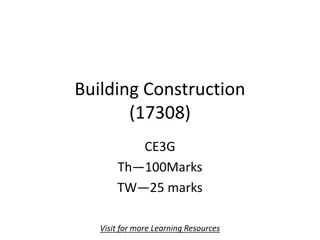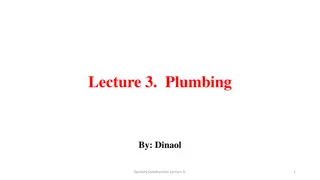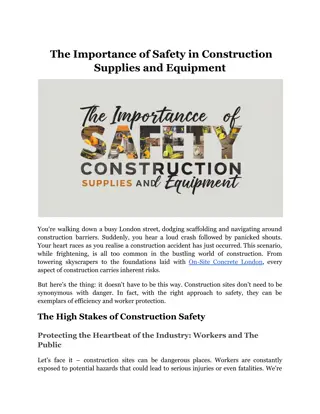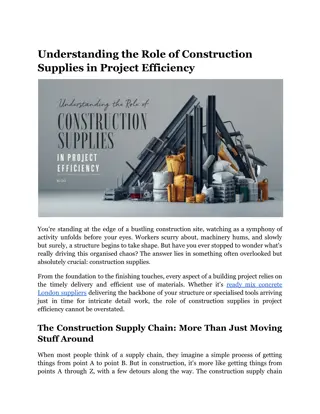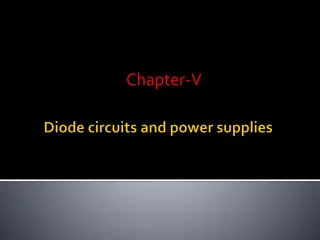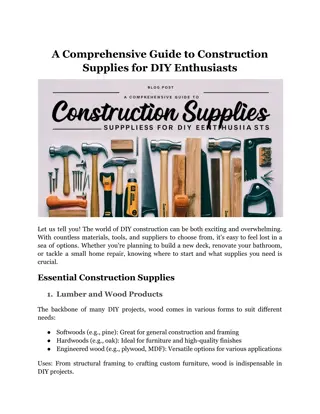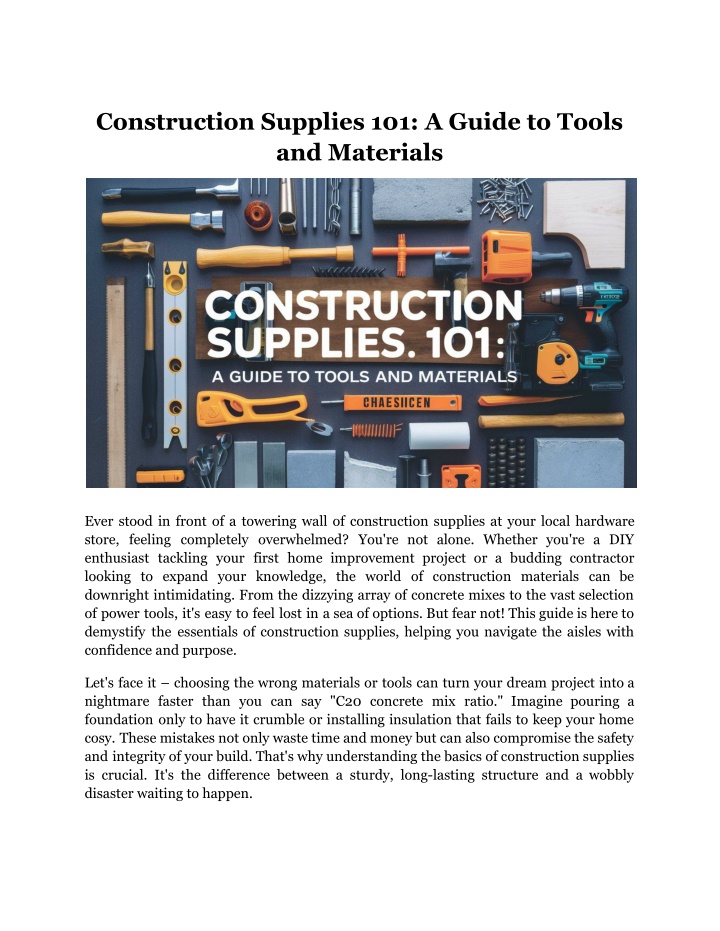
Construction Supplies 101_ A Guide to Tools and Materials
Discover the must-have tools and materials for every construction project. A practical guide for beginners and pros alike.n
Download Presentation

Please find below an Image/Link to download the presentation.
The content on the website is provided AS IS for your information and personal use only. It may not be sold, licensed, or shared on other websites without obtaining consent from the author. If you encounter any issues during the download, it is possible that the publisher has removed the file from their server.
You are allowed to download the files provided on this website for personal or commercial use, subject to the condition that they are used lawfully. All files are the property of their respective owners.
The content on the website is provided AS IS for your information and personal use only. It may not be sold, licensed, or shared on other websites without obtaining consent from the author.
E N D
Presentation Transcript
Construction Supplies 101: A Guide to Tools and Materials Ever stood in front of a towering wall of construction supplies at your local hardware store, feeling completely overwhelmed? You're not alone. Whether you're a DIY enthusiast tackling your first home improvement project or a budding contractor looking to expand your knowledge, the world of construction materials can be downright intimidating. From the dizzying array of concrete mixes to the vast selection of power tools, it's easy to feel lost in a sea of options. But fear not! This guide is here to demystify the essentials of construction supplies, helping you navigate the aisles with confidence and purpose. Let's face it choosing the wrong materials or tools can turn your dream project into a nightmare faster than you can say "C20 concrete mix ratio." Imagine pouring a foundation only to have it crumble or installing insulation that fails to keep your home cosy. These mistakes not only waste time and money but can also compromise the safety and integrity of your build. That's why understanding the basics of construction supplies is crucial. It's the difference between a sturdy, long-lasting structure and a wobbly disaster waiting to happen.
Basic Construction Materials When it comes to building, three materials reign supreme: concrete, steel, and wood. Each has its unique properties and best-suited applications. Let's break them down: 1. Concrete: The Foundation of Modern Construction Concrete is like the Swiss Army knife of construction materials versatile, reliable, and essential for countless projects. From towering skyscrapers to humble garden paths, concrete's strength and durability make it a go-to choice for builders worldwide. Key Features: Compression strength: Concrete excels at bearing heavy loads Durability: Resistant to fire, weather, and wear Versatility: Can be molded into various shapes and forms Fun Fact: The ancient Romans were master concrete makers, creating structures like the Pantheon that have stood for nearly 2,000 years! Read More Article: Best Times to Book Private Flights from Los Angeles to San Francisco 2. Steel: The Backbone of Structural Integrity If concrete is the muscle of construction, steel is the skeleton. Its unmatched strength-to-weight ratio makes it indispensable for creating robust frameworks and reinforcements. Key Features: Tensile strength: Excellent at withstanding pulling forces Ductility: Can bend without breaking, crucial for earthquake-resistant designs Recyclability: One of the most recycled materials on the planet Did You Know? The Eiffel Tower, built in 1889, contains 7,300 tons of steel that's about 1,000 elephants worth of metal! 3. Wood: Nature's Timeless Building Block Despite advancements in modern materials, wood remains a beloved choice for its warmth, beauty, and workability. From framing to finishing, wood's versatility shines through in countless applications.
Key Features: Sustainability: When sourced responsibly, wood is a renewable resource Insulation: Natural thermal and acoustic properties Workability: Easy to cut, shape, and join with simple tools Interesting Tidbit: The world's tallest wooden skyscraper, Mj st rnet in Norway, stands at an impressive 85.4 meters (280 feet) tall! Comparison of Basic Construction Materials Material Strength Durabili ty Workabilit y Sustainability Concrete High Excellent Moderate Moderate Steel Very High Excellent Moderate High (recyclable) Wood Moderate Good Excellent High (renewable) Specialised Construction Materials While concrete, steel, and wood form the core of most builds, specialised materials play crucial roles in enhancing performance, comfort, and longevity. Let's explore some key players: 1. Insulation Proper insulation is like a cosy sweater for your home, keeping the warmth in during winter and the heat out during summer. It's a game-changer for energy bills and comfort levels. Types of Insulation: Fiberglass: The classic pink stuff, affordable and effective Spray foam: Provides an airtight seal, great for oddly shaped spaces Cellulose: Made from recycled paper products, an eco-friendly option Pro Tip: Don't skimp on insulation! The upfront cost pays for itself in energy savings over time.
2. Waterproofing Water is sneaky it can find its way into the tiniest cracks and wreak havoc on your structure. Good waterproofing is essential for preventing moisture-related headaches like mold, rot, and structural damage. Common Waterproofing Materials: Liquid membranes: Easy to apply, great for complex shapes Sheet membranes: Durable and reliable for large flat surfaces Crystalline waterproofing: Penetrates concrete, creating a water-resistant barrier Remember: It's much easier (and cheaper) to waterproof during construction than to fix water damage later! 3. Adhesives and Sealants These hold everything together literally. From gluing tiles to sealing windows, adhesives, and sealants play a crucial role in construction. Popular Types: Construction adhesives: Strong bonds for heavy-duty applications Silicone sealants: Flexible and waterproof, great for gaps and joints Epoxy: Two-part adhesive for extra-strong bonds Fun Fact: Some modern adhesives are so strong they can hold together entire wooden structures without nails or screws! Basic Tools and Equipment Now that we've covered materials, let's talk about the tools that bring them to life. Having the right tools not only makes your job easier but also ensures better results. Hammers From driving nails to demolition work, hammers are the Swiss Army knives of the tool world. Types of Hammers: Claw hammer: Your all-purpose nail driver and remover
Framing hammer: Heavier, for rough carpentry work Sledgehammer: When you need some serious demolition power Pro Tip: Invest in a quality hammer with a comfortable grip your hands will thank you after a long day of work! Screwdrivers Whether you're assembling furniture or installing electrical outlets, a good set of screwdrivers is essential. Must-Have Screwdrivers: Phillips head: For those cross-shaped screws Flathead: For slotted screws and prying tasks Multi-bit screwdriver: Space-saving option for various screw types Pliers From bending wire to holding small parts, pliers are incredibly versatile tools. Essential Plier Types: Needle-nose pliers: For precision work in tight spaces Linesman's pliers: Heavy-duty for cutting and gripping Adjustable pliers (Channel locks): For gripping various sizes of pipes and fittings Drills A good drill is like having a super-powered screwdriver and hole-maker in one. It's a game-changer for efficiency and precision. Drill Options: Corded drills: Consistent power for heavy-duty work Cordless drills: Portable and convenient for most jobs Hammer drills: For drilling into masonry and concrete Saws Different materials and cuts require different saws. Here are some must-haves:
Essential Saws: Circular saw: For straight cuts in wood and sheet materials Reciprocating saw: Versatile for demolition and rough cuts Miter saw: For precise angled cuts, perfect for trim work Nail Guns When you've got a lot of nailing to do, nail guns can save your arm (and your time). Popular Nail Gun Types: Framing nailer: For heavy-duty framing work Finish nailer: For trim and molding Brad nailer: For delicate wood pieces and crafts Tool Comparison for Different Project Types Project Type Essential Tools Basic DIY Hammer, Screwdrivers, Pliers, Cordless Drill Carpentry Circular Saw, Miter Saw, Nail Gun, Framing Square Plumbing Pipe Wrench, Adjustable Pliers, Pipe Cutter Electrical Wire Stripper, Voltage Tester, Needle-nose Pliers Read More Article: Everything You Need to Know When Flying from Austin, TX Proper Storage and Handling of Construction Supplies Taking care of your materials and tools isn't just about tidiness it's about safety, efficiency, and making your investments last. Here are some key tips: Storage Practices: Keep materials off the ground: Use pallets or shelves to prevent moisture damage Organise by project or type: Makes finding what you need a breeze
Climate control: Some materials (like wood) are sensitive to temperature and humidity changes Handling Techniques: Use proper lifting techniques: Bend your knees, not your back! Know your limits: Don't be a hero use equipment or ask for help with heavy loads Wear protective gear: Safety glasses, gloves, and steel-toed boots can prevent injuries Pro Tip: Create a dedicated space for frequently used tools. A pegboard with outlines for each tool makes it easy to see what's missing at a glance. Conclusion Navigating the world of construction supplies doesn't have to be daunting. By understanding the basics of materials, tools, and proper handling techniques, you're setting yourself up for success in any building project. Remember, the right supplies are only part of the equation proper planning, safety precautions, and a willingness to learn are equally important. Whether you're mixing your first batch of concrete or planning a major renovation, keep this guide handy. And don't forget the C20 concrete mix ratio might just be the key to your next rock-solid project. Looking for reliable concrete mixes that deliver consistent results? Pro-Mix Concrete s expertly formulated blends, including the popular C20 mix, take the guesswork out of your projects. With Pro-Mix, you'll build with confidence, knowing you're using materials trusted by professionals. Strength, durability, and peace of mind that's the Pro-Mix promise. Happy building! Site Article: Construction Supplies 101: A Guide to Tools and Materials








